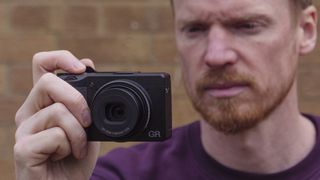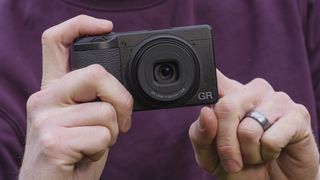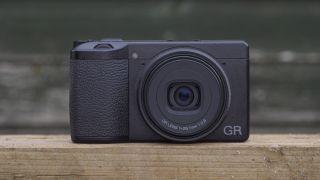Ricoh GR IV: 5 things I want to see
If you want a discreet, everyday camera that fits easily in your pocket, you can't really go wrong with the Ricoh GR III series. And fans of the street photography snapper got a big boost when Ricoh GR designer Inaba San dropped a hint during an interview (shared on Ricoh's YouTube earlier this month) that a fourth installment is in the pipeline (see video link below, starting at 20:58).
With a 24MP APS-C sensor and smart features like Snap autofocus, the GR III offers pretty much the best image quality you can get from a truly compact, pocket-sized camera. In fact, it's so good that I spent around $1,000 / £900 on the GR IIIx instead of the latest iPhone (the GR III but otherwise the same). And eighteen months later, I still love it.
Such is the cult status and growing popularity of these specialized fixed-lens compact cameras that, thanks in part to the Fujifilm X100V, it's becoming increasingly difficult to get a GR IIIx. That's not too surprising, considering they're some of the best compact cameras around – so there's naturally a lot of excitement at the prospect of a new model.
After 18 months with my own GR IIIx, I can speak from deep hands-on experience about both the good and the bad of the series. These aren't perfect cameras, but a few tweaks can go a long way toward creating what, for me, would be an even better pocket shooter. Below are the things I'd like to see in a potential Ricoh GR IV, in order of importance.
1. Stay small
When I was looking for a camera for everyday use in 2021, the As impressive as the X100V is, it was just too big for me. I wanted the best possible quality from a small camera that I could fit in my pocket and always have with me without having to think about it.
The GR III / GR IIIx meets this requirement. Sure, it's a more basic camera in many ways, and there are features that can be added to improve the GR III shooting experience, but if that requires larger dimensions then it's a no from me. The size (small body and large sensor) is the main feature of the GR series cameras.
2. Add a built-in flash
I use my own GR IIIx for everyday photography, not just street photography, and the everyday includes nights out with friends, often in dimly lit environments. On many occasions I've wished for a built-in flash to add a little spice to the portraits of my friends and family, but instead I've had to live with flat-looking high ISO images with noise, or use a slow shutter speed. . I could be buy a bulky external flash that attaches to the hot shoe (Ricoh sells two flashes), but such bulky accessories negate the compact nature of GR III cameras. If the GR IV were to have a flash, it would obviously have to be a pop-up flash that doesn't require a larger camera body. Of all the features I would like to see in the Ricoh GR IV, a built-in flash is at the top of my list.
3. A more robust construction
I have had two (fixable) problems with my own GR IIIX in these 18 months: the menu button stuck and the lens stuck. The former was a cheap solution that could be avoided with better sealing (ultimately better weatherproofing), while the latter can be helped by using an optional lens protector. In the case of the menu button, there was residue in it that caused it to stick, which could have been avoided if all the buttons and controls were better sealed.
As for the lens, there's an optional lens protector that can prevent damage from impacts, plus a protective camera bag. These are useful accessories to buy, but personally I opted against them as they make the whole package much bulkier and less pocketable. Don't get me wrong, the GR III is well made, but an even more robust build quality for the GR IV so I can throw it in my pocket unprotected would be appreciated by discerning photographers like me.
4. A tilting LCD screen for versatile viewing
To view and compose images with the GR III / GR IIIx, users rely on an impressive fixed 3-inch touchscreen. When I used this everyday camera, especially for street photography, I often wanted a tilt screen to make shooting from awkward angles easier, especially shots at floor and waist height. There's also no option for an EVF, despite the hot shoe (having tried an optional optical viewfinder, I'm still not convinced a small EVF accessory would be of much use). However, a simple tilt mechanism for the LCD screen would be welcome. That comes with the caveat that we have to keep the same dimensions as the GR III, which would be a tough ask; Typically, a tilt screen requires a small increase in depth. If it were just a small increase, and the rumored GR IV was still pocketable, it would be a big win.
5. More reliable autofocus
If you're a Ricoh GR III fan, you're probably thinking Why isn't battery life listed yet? It's true that the GR III's battery life is poor, but for me it's 100% an acceptable trade-off for the small size of the camera. After all, tangibly better battery life means a physically larger battery and a larger camera body – no thanks. Instead, buy a spare battery or two: they're small and third-party options are super cheap.
My fifth question is rather better autofocus performance. Although I have the option of the intuitive snap autofocus (for a predetermined autofocus distance), I usually opt for single-point touch autofocus. Performance is decent in high contrast light, but when the light fades you may experience focus hunting. I think the most intuitive autofocus mode is the single-point touch focus – I just wish this was more reliable.
Final thoughts
The Ricoh GR IIIx is one of my favorite cameras, if any, and a successor doesn't have to bring much to the table to become one of the best compact cameras around. I expect a potential GR IV will have the same fixed 28mm f/2.8 lens, and if there is a GR IVx, that camera will have a 40mm f/2.8 lens.
If I were to ask for more, a rumored GR IV could benefit from more pixels which would in turn make the crop modes even more useful. I use the crop modes a lot on the GR IIIx, especially the 71mm mode with the macro photography option, but those files are only 7.5 MP. For example, if the GR IV had a 32.5MP APS-C sensor (that sensor already exists in cameras like the Canon EOS R7), then the most extreme crop mode would be a better 10MP. A successor could also outperform the GR III's full HD 1080p video at up to 60fps – 4K video is the norm these days.
However, anyone who's used the GR III will tell you that it's the shooting experience that would benefit most from a few tweaks, not the image quality. I don't expect huge improvements in a potential GR IV, but I hope for a more refined and robust pocket shooter.



